Audit of International Assistance to Tanzania
Audit report
Office of the Chief Audit Executive
June 2023
Table of Contents
Executive summary
In accordance with Global Affairs Canada’s approved 2021-2022 Risk-Based Audit Plan, the Office of the Chief Audit Executive conducted an Audit of International Assistance to Tanzania.
Objective
To assess whether the Department has put in place a management framework for bilateral development assistance in Tanzania to support effective program delivery and manage funds in accordance with applicable legislations and policies.
Scope
The audit covered bilateral development assistance provided to Tanzania in the last five fiscal years (April 1, 2017 up to December 31, 2022).
The audit primarily focused on the Tanzania Development program (WEG), as the departmental lead for bilateral development in the country. However, the audit scope included all bilateral development programming.
Conclusion
The department has a management framework for bilateral development assistance in Tanzania, which generally supports effective program delivery and the management of funds in accordance with applicable legislations and policies. There is an opportunity to improve coherence across programs operating in Tanzania, especially related to strategic direction and oversight.
Recommendation
A recommendation was made to address a key finding on monitoring.
No recommendations were made with regards to governance and oversight, risk-management, and results-based management as these issues are already being addressed at the departmental level through the Grants and Contributions Transformation Initiative and other actions.
About the audit
Objective
To assess whether the Department has put in place a management framework for bilateral development assistance in Tanzania to support effective program delivery and manage funds in accordance with applicable legislations and policies.
Audit Criteria
- Strategic direction for bilateral development assistance in Tanzania is clearly defined and supported by effective oversight.
- Risks that may impact the delivery of bilateral development assistance in Tanzania are identified, assessed, and mitigated.
- Effective controls are in place to deliver projects in accordance with applicable policies, procedures, and terms and conditions.
- Performance information and relevant data is collected, analyzed, and used to inform decision-making regarding international assistance to Tanzania.
Audit Scope
The audit covered bilateral development assistance provided to Tanzania in the last five fiscal years (April 1, 2017 up to December 31, 2022).
The audit primarily focused on the Tanzania Development program (WEG), as the departmental lead for bilateral development in the country. However, the audit scope also included bilateral development programming by the Partnerships for Development Innovation (KFM), the Assistant Deputy Minister of Global Issues and Development (MFM), and the geographic branch for the Americas (NGM).
The audit was conducted in conformance with the Institute of Internal Auditors’ International Standards for the Professional Practice of Internal Auditing and with the Treasury Board Policy and Directive on Internal Audit, as supported by the results of the quality assurance and improvement program.
Audit Methodology
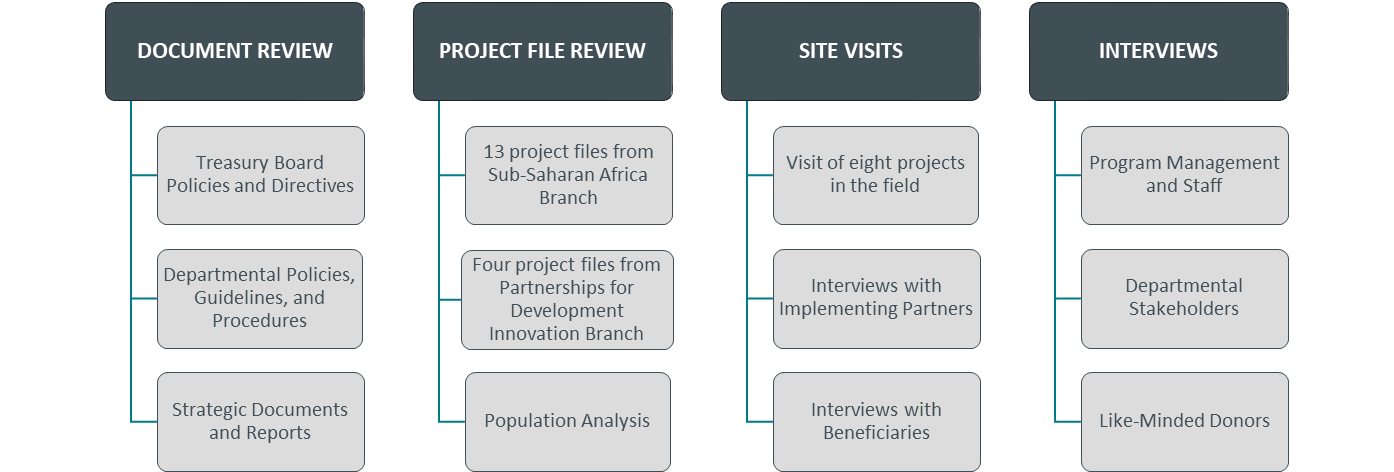
Text version
This diagram shows the audit methodology.
Document review:
- Treasury Board policies and directives
- Departmental policies, guidelines, and procedures
- Strategic documents and reports
Project file review:
- 13 project files from Sub-Saharan Africa Branch
- Four project files from Partnerships for Development Innovation Branch
- Population analysis
Site visits:
- Visit of eight projects in the field
- Interviews with implementing partners
- Interviews with beneficiaries
Interviews:
- Program management and staff
- Departmental stakeholders
- Like-minded donors
Background
Canada’s international assistance
Key Concepts
Canada's international assistance includes all financial resources provided by Canadian governments (federal, provincial, or municipal) to support economic, environmental, social, and political development in other (primarily developing) countries. It includes:
- Development Assistance
- Humanitarian Assistance
- Peace and Security
The International Assistance Envelope (IAE) is a dedicated, whole-of-government pool of resources for international assistance. The International Assistance Envelope (IAE) funds the majority of Canada’s international assistance. Most of the activities funded by the IAE qualify as Official Development Assistance (ODA) and comply with the requirements of Canada’s Official Development Assistance Accountability Act.
Official Development Assistance (ODA) is funding to eligible countries and multilateral institutions which is provided by official agencies, administered with the promotion of the economic development and welfare of developing countries as its main objective and concessional in character.
Official Development Assistance Accountability Act (ODAAA) aims to ensure that all Canadian ODA is focused on poverty reduction and is consistent with aid effectiveness principles and Canadian values. Canada’s ODA must:
- contribute to poverty reduction;
- take into account the perspectives of the poor; and
- be consistent with international human rights standards.
The Feminist International Assistance Policy
The Government of Canada’s overarching principles for international assistance are outlined in its Feminist International Assistance Policy (FIAP). The FIAP recognizes that supporting gender equality and the empowerment of women and girls is the best way to build a more peaceful, more inclusive and more prosperous world. It outlines six action areas where Canada will focus its efforts.
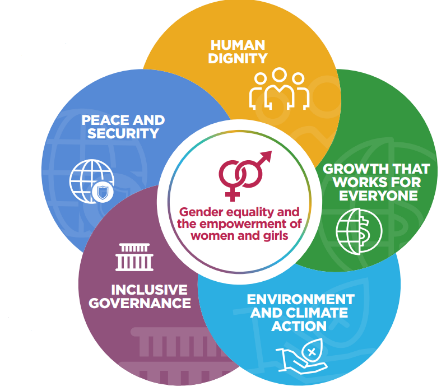
Text version
This figure depicts the six actions areas of the Feminist International Assistance Policy (FIAP) and how they align with the central core action area of gender equality and the empowerment of women and girls. The other five action areas are: human dignity, growth that works for everyone, environment and climate action, inclusive governance, and peace and security.
International Assistance to Tanzania
Tanzania is the eighth largest recipient of Canada’s international assistance globally and fifth largest recipient in Africa. In 2021-22, Canada disbursed $127 million in international assistance in Tanzania.
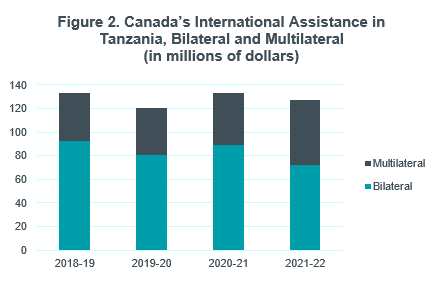
Text version
This chart represents Canada’s total International Assistance funding in Tanzania (for both bilateral and multilateral) in millions of dollars, for the fiscal years 2018-19 to 2021-22.
| International Assistance funding (in millions) | 2018-2019 Funding | 2019-2020 Funding | 2020-2021 Funding | 2021-2022 Funding |
|---|---|---|---|---|
| Bilateral | $92.2 | $80.7 | $90.1 | $72.6 |
| Multilateral | $40.6 | $40.2 | $43.7 | $54.4 |
| Total | $132.8 | $120.9 | $133.8 | $127.0 |
In 2021-22, Global Affairs Canada disbursed 78% of Canada’s international assistance in Tanzania.
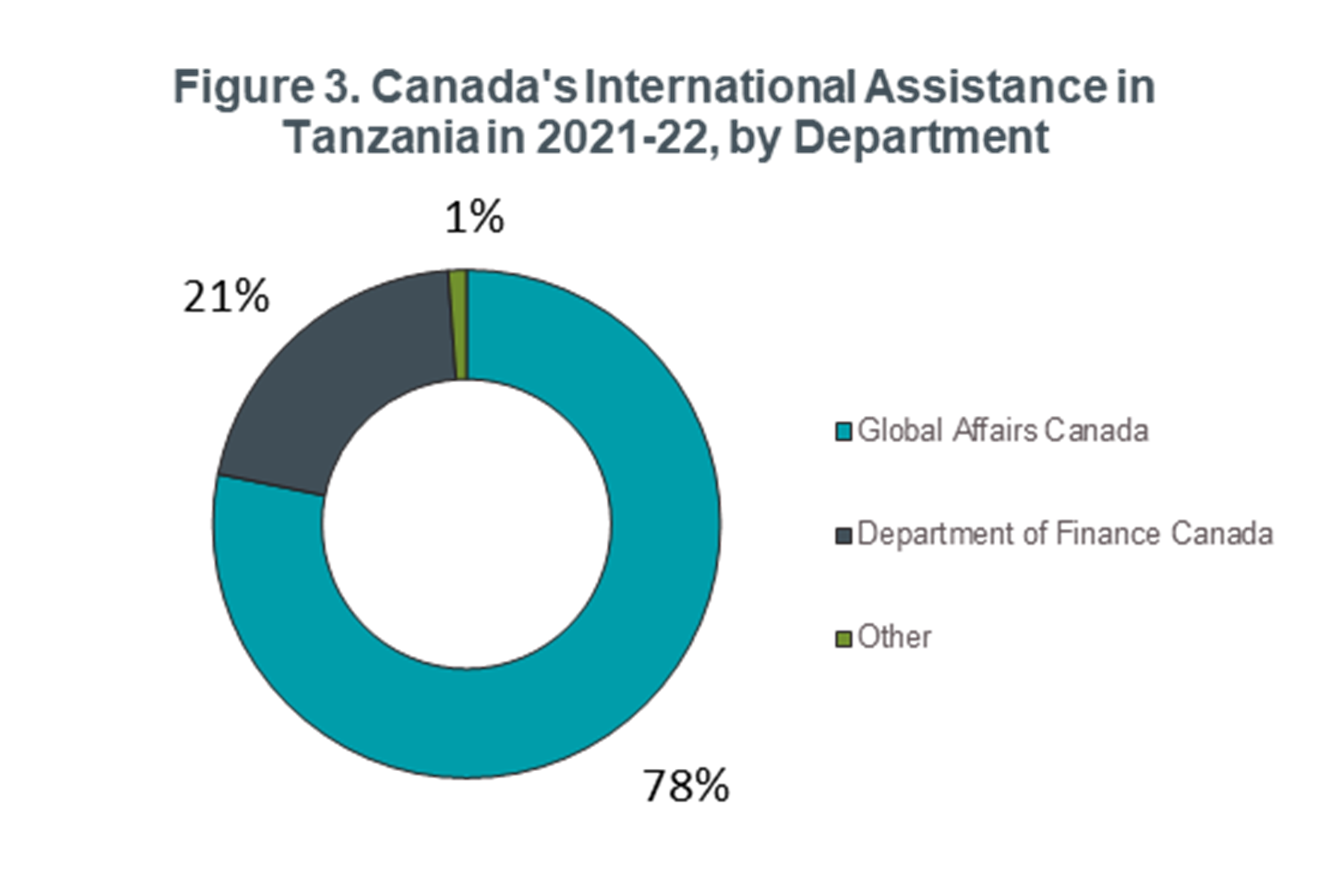
Text version
This chart represents the distribution of the Government of Canada’s international assistance funding in Tanzania in 2021-22, by department.
| International Assistance funding | 2021-2022 |
|---|---|
| Global Affairs Canada | 78% |
| Department of Finance Canada | 21% |
| Other | 1% |
Global Affairs Canada
Key Internal Stakeholders
Sub-Saharan Africa Branch (WGM)
- Acts as the main vector to advance, support, and coordinate Canada’s foreign policy objectives in Tanzania.
- Delivers programming, policy dialogue, and stakeholder engagement activities.
Partnerships for Development Innovation Branch (KFM)
- Supports development projects that are delivered by Canadian organizations, in cooperation with their counterpart organizations in developing countries.
- International Assistance Operations (KPD): Provides guidance, advice, tools and training to programming Branches on how to operationalize international assistance.
- The Grants and Contributions Transformation Bureau (KFMT) coordinates strategic planning and programme operations, engages internal and external partners, prepares reports, and develops technical solutions for the transformation.
Global Issues and Development Branch (MFM)
- Advances Canadian priorities through policy leadership, managing global investment and delivering advice for delivering humanitarian assistance. It is also the lead for Canadian engagement with multilateral and global organizations.
Americas Branch (NGM)
- Delivers Canada Fund for Local Initiatives (CFLI) projects globally, including in Tanzania.
Corporate Planning, Finance and Information Technology Branch (SCM)
- Responsible for financial management services and overseeing activities to ensure prudent use of financial resources, including grants and contributions’ policy and operations.
Strategic Policy Branch (PFM)
- Designs, delivers, and coordinates strategic policy advice on international assistance matters and leads the Department’s evaluation, results and delivery, research and foresight, and data strategy coordination functions.
International Assistance to Tanzania – Disbursements by Branch
The Sub-Saharan Africa Branch (WGM) is responsible for disbursing the majority of the department’s assistance in Tanzania. In addition to Sub-Saharan Africa (WGM), there are three branches that deliver bilateral development assistance in Tanzania: Global Issues and Development (MFM), Partnerships for Development Innovation (KFM), Americas (NGM).
In FY 2021-22, WGM was responsible for 40 projects and accounted for a disbursement of $63.7M (91% of total disbursement), while KFM was responsible for 17 projects and accounted for a disbursement of $6.4M (9% of total disbursement).
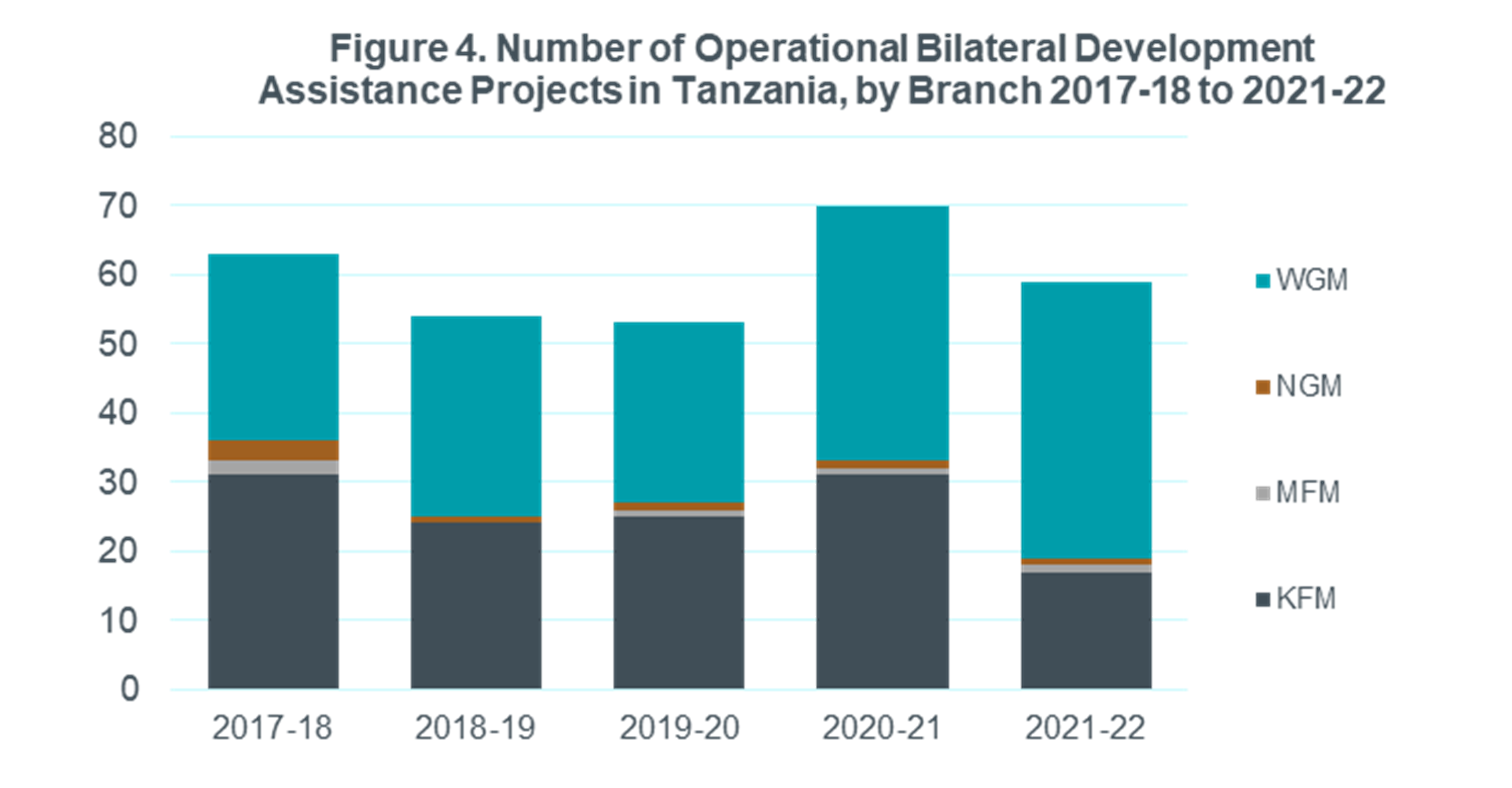
Text version
This chart represents a snapshot of the number of operational bilateral development assistance projects in Tanzania from 2017-18 to 2021-22, by Branch.
| Branch | 2017-2018 | 2018-2019 | 2019-2020 | 2020-2021 | 2021-2022 |
|---|---|---|---|---|---|
| WGM | 27 | 29 | 26 | 37 | 40 |
| NGM | 3 | 1 | 1 | 1 | 1 |
| MFM | 2 | 0 | 1 | 1 | 1 |
| KFM | 31 | 24 | 25 | 31 | 17 |
The Grants and Contributions Transformation Initiative
As part of the FIAP, Global Affairs Canada committed to (1) streamlining and accelerating its funding and reporting procedures; (2) reducing administrative burden on funding recipients; and, (3) being more responsive, transparent and predictable.
In July 2022, the Department launched the Grants and Contributions Transformation Initiative to deliver on these commitments. The Transformation Initiative aims to address six focus areas: (1) internal operations, (2) data collection and centralization, (3) risk assessment and management, (4) project financial management, (5) results-based management, and (6) transparency and efficiency for partners.
The Transformation Initiative will include:
- changes to existing processes;
- new processes to facilitate work at the portfolio level;
- new ways of working with partners;
- new ways of collecting and using data for decision-making, and;
- different ways of telling the department’s story.
The Transformation Initiative is set to be delivered in three phases; each approximately 18 months:

Text version
Phase 1: July 2022 to December 2023
Phase 2: January 2024 to July 2025
Phase 3: July 2025 to June 2027
Audit findings
Oversight and governance
Coherence at the Country Level
At the departmental level, the International Assistance Operations Committee is responsible for oversight and decision-making on matters of operational importance for international assistance. Records of decisions demonstrate that the committee is an effective forum for oversight and decision-making. However, specific country programs are not discussed.

Text version
This chart depicts the departmental branches with bilateral assistance projects in Tanzania.
Bilateral International Assistance in Tanzania is subdivided in three categories: international development assistance, humanitarian assistance, and peace and security.
International Development Assistance is disbursed by four branches: WGM, KFM, MFM, and NGM.
Humanitarian Assistance is disbursed by MFM.
Peace and Security is disbursed by the Political Director and Assistant Deputy Minister, International Security and Political Affairs (IFM).
Coherence at the Country Level
At the country level, there is no oversight mechanism to coordinate international assistance or bilateral development assistance to Tanzania across the department.
- While WGM is responsible for Canada’s bilateral relationship in Tanzania, it has limited visibility over what other branches are doing in the country.
- There is no formal mechanism for coordination between branches, which may prevent them from creating synergies and increase the potential of overlap. Coordination is based on ad hoc communications between program officials. Interviews confirmed that there is a need for greater coordination between branches working in Tanzania.
In the absence of country level oversight, there may be a lack of coherence and efficiency in departmental programming in Tanzania.
The Global Affairs Canada Audit of Grants and Contributions – Oversight and Monitoring (2021) included a recommendation for the establishment of a department-wide governance framework, including roles, responsibilities and accountabilities to formalize the governance for grants and contributions.
Strategic direction
Coherence at the Country Level
In recent years, there has been increased focus on the importance of integrated country level strategic planning and programming to support effective international assistance.

Text version
This chart depicts the timeline of the recommendations for integrated country strategies.
In 2016, the House of Commons Standing Committee on Foreign Affairs recommended that Global Affairs Canada publish long-term country strategies.
Then, in 2017, the Feminist International Assistance Policy called for a more integrated approach that includes diplomacy, trade, and security. According to the policy, better integration of development and other objectives can have positive economic effects for developing countries—and for Canada.
Finally, in 2020, the department’s Executive Committee approved a comprehensive work plan to adopt a Triple Nexus approach. This approach aims to strengthen collaboration, coherence and complementarity between three pillars: development, humanitarian, and peace. The Work Plan commits to developing tools for better integrated international assistance and revisiting and publicly sharing country strategy documents.
The Evaluation Bureau at Global Affairs Canada has conducted evaluations on coherence across diplomacy, trade and international assistance and has also recommended integrated strategic planning across the aforementioned three streams.
Coherence at the Country Level
The department does not have a mechanism for integrated strategic planning at the country-level.
- Strategic direction elements are dispersed in the Bilateral Development Program’s (WEG) planning documents, namely its Results-based Management Framework, Strategia, and annual Development Investment Plan.
- However, none of these planning documents include activities conducted by other programming bureaus in the country.
In the absence of country level strategic direction, there may be a lack of coherence in departmental programs and it may be difficult to assess whether the department is achieving its desired results from a country perspective.
Integrated Country Strategies
In 2022, the International Assistance Operations Bureau (KPD) launched a pilot project to develop integrated country strategies on a voluntary basis. Three bilateral development programs are participating in the pilot: Tanzania, Peru, and South Sudan.
At the time of the audit, the draft strategy had been shared with departmental stakeholders. The final strategy would be presented to the Assistant Deputy Minister for approval.
Perspective: Like-Minded Donor: The United Kingdom and Switzerland have a strategy for Africa and Sub-Saharan Africa, respectively.
Project management
Compliance with Departmental Procedures
The Authorized Programming Process (APP) is the Department’s standardized, streamlined process for development projects. The APP provides clear steps and tools to reduce administrative burden and ensure compliance with applicable policies, directives, laws, and regulations.
The APP governs the entire life cycle for all development assistance. This cycle has six phases, through which all initiatives pass. The process’ streamlined information flow ensures that project officers complete the requirements of each phase before proceeding to the next phase.
Phases of the Authorized Programming Process

Text version
This chart depicts the order of the six phases of the Authorized Programming Process.
Step 1 is the Initiation Phase, where the starting point is defined.
Step 2 is the Work Planning Phase where tasks are scheduled.
Step 3 is the Design Phase where expectations are set.
Step 4 is the Assessment Phase where the proposal is assessed.
Step 5 is the Agreement Phase where the financial instrument is signed.
Step 6 is the Implementation Phase where the initiative is managed.
Compliance with Departmental Procedures
Based on the review of 17 sampled projects, where documents were available, the expected procedures of the APP were consistently followed.
Project documentation was not always readily available and, in some cases, missing.
- The main document depository system for Electronic Documents and Records Management Solutions (EDRMS) that is used for storing project files is not easily accessible to Project Officers in Dar es Salaam.
- Documentation related to project implementation (Annual Work Plans, detailed budgets, monitoring reports, and financial reports) was not always available.
- While the APP requires project officers to link key project documents in the Project Module of SAP, this was not fully done for any of the projects reviewed.

Text version
This chart depicts the proportion of documents requested from the client that were available during the course of the audit.
| Documentation requested | Availability |
|---|---|
| Available | 91% |
| Not available | 9% |
Grants and Contributions Transformation
One of the key initiatives is a new enterprise system to improve information management for international assistance.
The first release of this system is expected to be completed in December 2024.
This information management issue was raised in the Office of the Auditor General’s Audit on International Assistance in Support of Gender Equality (2023). There is an ongoing Management Action Plan to address this issue, which include an interim solution until the Grants and Contributions Transformation initiative is completed.
Gender Equality and Environmental Sustainability
To support the advancement of gender equality and the empowerment of women and girls, Project officers are required to consult a departmental Gender Equality Specialist on the quality of each initiative’s gender analysis and design.
Integrating environment and climate considerations in programming is essential to achieve sustainable development. Project officers are required to consult a departmental or local Environmental Specialist on potential issues, risk and opportunities, and mitigation and enhancement measures.
These assessments may include recommendations for the project officer to implement. These recommendations provided by the specialists are strictly advice and are not mandatory. It is ultimately the decision of the project officer whether to implement them or not.
- For all projects reviewed, gender equality and environmental assessments were completed, as required.
- In most cases, there was documented evidence that recommendations made by the gender and environment were implemented.

Text version
This chart represents the proportion of recommendations that were implemented.
| Proportion of recommendations that were implemented | Yes | Missing documentation |
|---|---|---|
| Gender Equality assessment | 82% | 18% |
| Environmental assessment | 83% | 17% |
Risk Management
In accordance with Treasury Board Policy on Transfer Payments, administrative requirements on recipients should be proportionate to the level of risks specific to the program, the materiality of funding and the risk profile of recipients.
As part of the APP, a Fiduciary Risk Evaluation Tool (FRET) must be completed for each project. Based on the level of assessed fiduciary risk, the FRET recommends the administrative effort by the recipient (the implementing partner) and the department. Overriding a FRET recommendation requires Director General approval.
The FRET was completed for all projects, however recommendations were not consistently followed.
- Where the FRET recommended that certain clauses be added to the financial instrument, this was consistently done. However, where the FRET recommended annual review, there was insufficient evidence to determine whether this was completed.
There is no formal, documented process to manage non-fiduciary risk at the project level.
- There is currently no departmental requirement for Project Officers to develop a risk management profile or use tools such the risk register, to help in assessing, managing and monitoring risks during the project life cycle.
- Based on the sample of projects reviewed, the audit did not find documented evidence that project risks are consistently identified, assessed, and mitigated.
Managing risks throughout the life-cycle of the project supports the achievement of project objectives and the delivery of the project in a timely manner and within budget.
Grants and Contributions Transformation
The FRET will be replaced by the Risk Management Component (RMC). The RMC will consolidate risk management into a single centralized IT solution and support consistent risk monitoring through the project lifecycle.
Planned delivery: December 2024 (release 1).
Project Monitoring
Ongoing monitoring is important for managing project performance and risk, ensuring compliance with the terms and conditions of the financial instrument, and ensuring value-for-money. Project officers monitor projects using a variety of tools and activities, based on project complexity and risk level. For instance, project officers review project reports provided by the implementing partner, conduct project site visits, communicate regularly with the implementing partner, and participate in governance meetings.
The Tanzania Bilateral Development Program’s RBM Framework includes a Monitoring and Evaluation Plan. However, it does not list planned monitoring activities nor specify the logistics, budgets and other operational details of data collection and analysis.
Project Officers monitor projects through performance reports and project governance, however monitoring visits were not well documented.
- 73% of sampled projects had all performance reports on file, as required.
- In all sampled projects with a governance committee, there was evidence of GAC participation.
- Based on interviews with Government of Tanzania and implementing partners, communication is effective.
- However, it was difficult to ascertain whether monitoring visits or project evaluations had been conducted for sampled projects, due to a lack of documentation (ex. monitoring visit reports).
- The audit noted that field monitoring was a challenge during the pandemic due to travel restrictions and health considerations.
The Global Affairs Canada Audit of Grants and Contributions – Oversight and Monitoring (2021) included a recommendation for the development of a departmental risk assessment framework, which should set out the expectations for risk based monitoring.
There is an ongoing Management Action Plan to address this issue.
Recommendation 1
The Assistant Deputy Minister of the Sub-Saharan Africa Branch (WGM) should develop and implement a monitoring strategy based on risk for Tanzania and ensure that monitoring visits are documented.
Performance management
Program and Country Level
In 2022, the department developed an internal process to measure and report on international assistance results at the program-level. As part of this process, programs are expected to develop a results-based management (RBM) framework and report against their RBM framework by aggregating MSRs into an annual report.
The department measures the results achieved at the program level (Tanzania Bilateral Development Program), but does not have a process to measure and report on results at the country level, across all programs operating in Tanzania.
- The Tanzania Bilateral Development Program developed a five-year RBM framework and reported on actual results achieved against its RBM Framework in July 2022.
- The Tanzania Bilateral Development Program’s RBM Framework and corresponding results report do not include bilateral programming conducted in Tanzania by programs in other branches.
- There is no departmental reporting on results at the country level.
In the absence of country level performance management, there is a risk that expected results may not be achieved, programming may not be contributing to departmental priorities, and issues may not be identified and addressed in a timely manner.
Perspective: Like-Minded Donor
Switzerland is moving away from reporting on the improvements brought about in specific fields by its programmes and projects. Instead, it reports towards thematic evaluations on the effectiveness of its aid.
Project Level Results
Project level results information are the foundation for most program/portfolio and corporate results assessments and reporting. As part of the APP, project officers are required to complete annually a Management Summary Report (MSR) documenting project results. The MSR serves three main purposes:
- Enabling better project and portfolio management by documenting key information, the program’s assessment of a project, and actions taken.
- Generating valuable information for institutional learning on themes such as innovation and experimentation, as well as for future evaluations and audits.
- Capturing information required for departmental reporting (ex. Department Results Report).
Management Summary Reports were completed for all reviewed projects, where required. However, the usefulness of MSRs for program management and institutional learning is not clear.
- Interviews indicated mixed responses with regards to the usefulness of MSRs for managing performance. It was noted by several individuals that the department’s performance measurement and reporting process is geared more towards corporate reporting requirements, which does not necessarily yield information that is useful for program management.
Grants and Contributions Transformation
The Results-based Management Component Project will re-think GAC’s International Assistance results management framework, including reporting and monitoring processes, to improve results management and tell a better results story at the project, portfolio, program and corporate levels.
Planned delivery: December 2023
Project Level Results
There is no mechanism to systematically share lessons learned.
- Lessons learned were captured in individual MSRs, however there was no evidence that they were rolled up or shared further.
- Departmental procedures indicate that lessons learned should be integrated during the implementation phase and shared to inform other similar current and future programming. However, there is no departmental guidance on how this should be done. Further, the audit team did not find any evidence that this was completed for any of the projects reviewed.
Systematically sharing lessons learned would allow the department to learn from past projects, repeat or scale its successes, and mitigate risk.
Field Visit Observations
The audit team visited seven projects in four regions of Tanzania: Dar es Salaam, Mbeya, Kigoma and Dodoma. The project sectors included reproductive health, education, and financial services. Interviews were conducted with implementing partners, government stakeholders, and beneficiaries.
The audit team noted both successes (ex. the program’s flexibility during the pandemic) and shortcomings (ex. project delays). These can provide important lessons that, if shared, future programming could learn from.
Conclusion and recommendation
Conclusion
The department has a management framework for bilateral development assistance in Tanzania, which generally supports effective program delivery and the management of funds in accordance with applicable legislations and policies. There is an opportunity to improve coherence across programs operating in Tanzania, as well as in the areas of risk management, monitoring, and results-based management.
Recommendation
The Assistant Deputy Minister of the Sub-Saharan Africa Branch (WGM) should develop and implement a monitoring strategy based on risk for Tanzania and ensure that monitoring visits are documented.
No recommendations were made with regards to governance and oversight, risk-management, and results-based management as these issues are already being addressed at the departmental level through the Grants and Contributions Transformation Initiative and other actions.
Management response and action plan
Recommendation: 1. The Assistant Deputy Minister of the Sub-Saharan Africa Branch (WGM) should develop and implement a monitoring strategy based on risk for Tanzania and ensure that monitoring visits are documented.
Management Response: Management agrees with the recommendation.
A program monitoring strategy is in the Tanzania Bilateral Development Program’s work plan for FY 2023-24. The strategy will incorporate a risk-based approach.
Tanzania project officers regularly produce monitoring reports; however, these are not consistently in the appropriate location within the departmental information management system.
Management Action Plan: The Tanzania Bilateral Development Program will develop a program monitoring strategy, which considers risk. The strategy will specify that the program will document all monitoring visits, ensuring appropriate information management approaches for all reports and leveraging existing and new guidance and tools supporting international assistance monitoring activities.
Sector Responsible: Assistant Deputy Minister of the Sub-Saharan Africa Branch
Planned Implementation Date: July 2024.
Summary of results
| Criterion | Description | Rating | Findings |
|---|---|---|---|
| Criterion 1 | The Department clearly defined a strategic direction for international assistance in Tanzania that is supported by effective oversight. | Needs Moderate Improvement | There is no oversight mechanism to coordinate international assistance or bilateral development assistance to Tanzania across the department. |
| The department does not have a mechanism for integrated strategic planning at the country-level. | |||
| Criterion 2 | The Department identifies, assesses, and mitigates risks that may impact the delivery of its international assistance in Tanzania. | Needs Moderate Improvement | The Fiduciary Risk Evaluation Tool was completed for all projects, however recommendations were not consistently followed. |
| There is no formal, documented process to manage non-fiduciary risk at the project level. | |||
| Criterion 3 | The Program has controls in place to deliver projects effectively in accordance with applicable policies, procedures, and terms and conditions. | Needs Improvement | Where documents were available, the expected procedures of the APP were consistently followed. Project documentation was not always readily available and, in some cases, missing. |
| The Tanzania Bilateral Development Program’s Results-Based Management Framework includes a Monitoring and Evaluation Plan. However, it does not list planned monitoring activities nor specify the logistics, budgets and other operational details of data collection and analysis. Project Officers monitor projects through performance reports and project governance, however monitoring visits were not well documented. | |||
| Criterion 4 | The Department collects, analyzes, and uses performance information and relevant data to inform decision-making regarding international assistance to Tanzania. | Needs Moderate Improvement | The department measures the results achieved at the program level (Tanzania Bilateral Development Program) but does not have a process to measure and report on results at the country level, across all programs operating in Tanzania. |
| Management Summary Reports were completed for all reviewed projects, where required. However, the usefulness of MSRs for program management and institutional learning is not clear. | |||
| There is no mechanism to systematically share lessons learned. |
- Date modified: